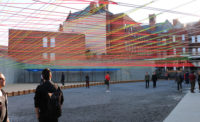In Switzerland, “As soon as the sun comes out, everyone jumps in the water,” says Tom Emerson, co-founder of London’s 6a Architects and professor at ETH Zurich. Naturally, the best place to build a temporary cinema in Zurich this summer was in the middle of a lake.
Earlier this month, Emerson unveiled the Pavilion of Reflections, a temporary timber structure equipped with bar, LED screen, theater seating and more. For the 100 days of Manifesta 11, the 2016 edition of the roving European contemporary art biennial, it will float on the surface of Lake Zurich and serve as a centerpiece to its programming.
Under the direction of Manifesta curator Christian Jankowski, the pavilion was conceived as a way of involving local residents as much as possible: it was both designed and built by 32 of Emerson’s students at ETH and was modelled after the Swiss tradition of the badi, or outdoor pool.
At the center of the pavilion, stairs descend into a shallow kiddie pool whose porous walls allow fresh lake water to circulate in and out. And, situated beneath a massive LED screen where short films will be shown throughout the summer, the lights reflecting off of the water give physical resonance to the pavilion’s name.
The layout mimics that of a European town square, says Emerson, with a kiddie pool in lieu of a fountain. Timber space frame structures—including a tower—define the perimeter. The bar features a dramatic roof redolent of the giant “M” that’s Manifesta’s logo. “Right now we’re sitting in the church,” Emerson says from the tribune seating facing the screen, the angled roof of which is a space frame wedge.
Each piece was fabricated off-site over the winter with simple materials—timber, screws, and chain-link fencing to fortify the railings of the observation deck—to economize both cost and time for students “with not much experience in building.” The components were assembled on top of a steel substructure outfitted with floating caissons, partly filled with water to counterbalance the pavilion’s heavier elements. After its foundation was completed, the pavilion was equipped with the requisite conveniences of both the traditional badi and the contemporary art exhibition: changing cabins, blowdryer stations, lockers equipped with phone chargers, and Wi-Fi. The whole thing is connected to the riverbank by a floating pier.
As the first built project for many of his students, the project was a lesson in working together, Emerson says. It is also a picturesque new public space for Zurich: from every angle, the Pavilion of Reflections cuts a clear profile against either the water or the city, especially at night, when lights inside the space frames transform the volumes into glowing lanterns. During the day, it’s a caricature of an idyllic Swiss summer: swimmers who jump off the perimeter deck (despite the signs that read “Schwimmen Verboten”) co-mingle with sailboats and swans. “Water is sacred here,” Emerson says. “If you really want to do a public space in Zurich, then do it on the lake.”
The Pavilion of Reflections by Studio Tom Emerson

Photo © Nora Hauswirth

Photo © Wolfgang Traeger

Photo © Wolfgang Traeger

Photo © Wolfgang Traeger

Photo © Wolfgang Traeger

Photo © Wolfgang Traeger


Post a comment to this article
Report Abusive Comment